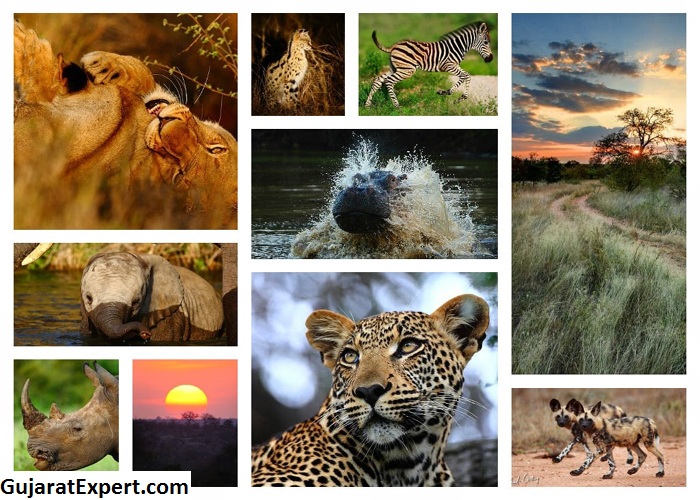
Gir National Park in Gujarat’s Junagadh district is wonderful wildlife conservation area and a veritable treat for both nature and animal lovers. The dense deciduous wildernesses of Gir serve as a perfect haven for the famous Asiatic lions and numerous other wildlife creatures. Also, there are numerous plant species here and together the plants and trees constitute the most congenial topography and natural environs for the wildlife to thrive. In other words Gir National Park, also referred to as Sasan Gir is blessed with a remarkably rich biodiversity and the factors contributing to such a highly enriched biodiversity are-
- Numerous perennial rivers course through this region
- All three seasons are experienced by this region
Gir National Park stretches across an area of about 1412 sq km and was founded in the year 1965. Each year numerous visitors from every nook and corner of the country make a bee line to Gir to catch a thrilling glimpse of the prowling ‘Big Cats’ and also to explore the thriving plant life of Gir. A large section of Gir visitors consists of the passionate wildlife researchers who visit the park with the purpose of studying its extravagant plant and animal life.
To know more about the Fauna and Flora of Gir, read on-
Gir National Park Fauna
Gir is blessed with the wealth of about 2375 diverse range of fauna species. According to latest statistics Gir conserves nearly 300 lion species and also 300 leopard species. But what makes Gir famous is its reserve of Asiatic lions. This is the only second place after Africa to have the Asiatic lions. Scientific name for Asiatic Lions is Panthera Leo and the Asiatic lions of Gir National Park are a little smaller when compared to the African ones. Apart from lions and leopards, Gir boasts of about 300 bird species, 37 reptile species, 38 mammal species, and 2000 insect species.
The Fauna of Gir may be categorized into the following groups-
Gir Carnivores
The major Carnivores one gets to see at Gir include Asiatic Lions, Indian Cobras, Indian Leopards, Sloth bears, Striped Hyenas, Golden Jackals, Indian Mongoose, Jungle cats, Desert cats, Indian Palm Civets etc.
Gir Herbivores
The major Herbivores that can be spotted here are wild boar, Nilgai, Chital, four horned Chinkara, Antelope, Sambar.
Gir Mammals
Smaller mammals like Hare, Porcupine may be spotted at Gir.
Gir Reptiles
Reptiles like Monitor Lizard, March crocodiles, Hir Tortoise, Pythons and snakes can be spotted at Gir.
Gir Birds
Pygmy woodpecker, Brown fish owl, Crested serpent eagle, crested Treeswift, black headed Oriole, Bonelli’s eagle, rock bush quail, Indian Pitta, Bonelli’s eagle, changeable Hawk eagle, Eurasian Griffon vulture, yellow-footed green pigeon, greenish warbler etc are some of the birds one can spot at Gir.
Gir National Park Flora
The topography of Gir National Park consists in a diverse range of flora. There are many types of evergreen plus semi-evergreen trees, deciduous trees, mixed forest zones, open and thorny scrub jungles & savannah type grasslands. However, mixed and deciduous forested belt occupies a major portion of the park and consists of mainly Teak trees. The evergreen broad leaved trees found at Gir include acacia, Banyan, babool, tendu, jamun, dhak, Zizyphas, Flame of the forest etc.
Plants such as Salia, Ber, Bamboo, Amla, Vad, Kalam, Khakro, Simal, Simai, umro, timru, dhavdo etc too are found in the forest. Deciduous trees are the dry type while the evergreen trees are shady, broad-leaved, moisture retaining trees. Trees such as Prosopis & Casuarina have been planted on the coastal belts by the state forest department. The forest also consists in few flowering trees. According to a survey conducted in the year 1955 nearly 400 plant species were traced at Gir. Later on these figures were revised in the course of several other subsequent surveys conducted by Baroda University’s Department of Botany.
The importance of flora at Gir National Park lies in the fact that this forest ground has turned out to be a vital biological research locale characterized by multiple aesthetic, educational, scientific plus recreational values.
Statistical records say that the annual harvesting at Gir yields green grass amounting to 5 million KGs and fuel wood amounting to about 123000 metric tons.
Essential Information on Gir National Park
List of wildlife sanctuaries of Gujarat
- Gaga Wildlife Sanctuary
- Jambughoda Wildlife Sanctuary
- Thol Wildlife Sanctuary
- Rampara Wildlife Sanctuary
- Pania Wildlife Sanctuary
- Hingolgadh Wildlife Sanctuary
- Khijadiya Wildlife Sanctuary
- Kutch Wildlife Sanctuary
- Nal Sarovar Bird Sanctuary
- Ratanmahal Sloth Bear Sanctuary
- Jessore Sloth Bear Sanctuary
- Purna Wildlife Sanctuary
- Barda Hills Wildlife Sanctuary
- Narayan Wildlife Sanctuary
- Balaram Ambaji Wildlife Sanctuary
- Shoolpaneshwar Wildlife Sanctuary
- Gir Wildlife Sanctuary
- Wild Ass Sanctuary
- Marina National Park
- Vansda National Park
- Blackbuck National Park
- Gir Forest National Park
- Flora Fauna Gir National Park
- Devaliya National Park


Leave a Reply